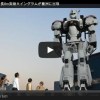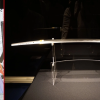
When disaster zones are inaccessible by ground—such as the areas of Japan hit by widespread and deadly flooding last week—news broadcasters typically take to the air, relaying footage from helicopters. In the city of Joso, Ibaraki, news helicopters captured dramatic footage of rescue teams winching people to safety from rooftops on Thursday after the Kinugawa River burst its banks.
But helicopters can only get so close, and so authorities in Japan are now using drones to capture footage in disaster areas. The drones can fly closer to disaster-hit areas than a manned helicopter, offering a different and dramatic perspective.
And drones are not only being used to survey these areas hit by flooding and landslides; they are also starting to be used in rescue missions.
The national Geospacial Information Authority, which is responsible for mapping and surveying Japan’s land, has released videos of footage captured by drones surveying the widespread flooded area around the Kinugawa River.
The resulting videos offer a lower-angled view of the area, offering a perspective that circling helicopters couldn’t have captured:
https://www.youtube.com/watch?t=1&v=tFAnNyetBG8
▼ Japanese commenters expressed shock at the scenes, with one saying “It looks like the Amazon or somewhere…not Japan.”
https://www.youtube.com/watch?v=2WWeYknQ-94
Two days of exceptionally heavy rainfall caused the Kinugawa River to break its banks, sending a wall of water that carried away homes and cars. The Geospacial Information Authority, which has its main offices in Ibaraki Prefecture, was able to use drones to survey the area and understand the extent of the flooding.
Elsewhere in Japan, drones are already being used to explore dangerous environments without putting rescuers’ lives at risk. Prefectural police in Aichi and Nara both began using drones to search for trapped survivors in training exercises this year. And unmanned vehicles have been used to explore volcanoes after eruptions, such as in Mt. Hakone, Mt. Ontake and Sakurajima.
Amongst the excitement about the possibility of increased use of drones, however, some voices called for caution:
▼ “Some people think we should use drones for everything, but they can’t be used all the time. And when rescue helicopters are flying overhead, drones could cause another accident.”
https://twitter.com/pori_pate/status/642205204289466368▼ “In a comparatively small disaster site such as this one, airspace needs to be clearly divided for rescue helicopters and drones [to avoid collisions].”
今回のように比較的狭い被災地だと、自衛隊等の救助ヘリと調査用ドローンの空域を事前に整理しておかないとね。川の上空20mはドローン空域かな。
— ZF ⚡ (@ZF_phantom) September 11, 2015
国土地理院がドローン撮影した鬼怒川決壊地点の衝撃(dragoner) - Y!ニュース http://t.co/zqSNybRbVS
As unmanned craft become increasingly common in disaster relief efforts, we’re sure there will be more discussion about the importance of avoiding causing any extra risk to rescue teams or disaster victims. But if drones can reach those in need more quickly and safely than traditional methods, that’s a step forward we should all be applauding.
Sources: Yahoo! News JP via Naver Matome, BBC News
Featured image: YouTube

 Single “Hebel Haus” is the only structure to defy the flooding of Japan’s Angry Demon River
Single “Hebel Haus” is the only structure to defy the flooding of Japan’s Angry Demon River Twitter user caught in Ibaraki flood tweets photos of his rescuers from inside helicopter
Twitter user caught in Ibaraki flood tweets photos of his rescuers from inside helicopter Flood victims send SOS tweets on Twitter in wake of Typhoon Hagibis
Flood victims send SOS tweets on Twitter in wake of Typhoon Hagibis Following flooding in Japan, Twitter users debate the history of the river’s “Angry Demon” name
Following flooding in Japan, Twitter users debate the history of the river’s “Angry Demon” name Japanese couple capture their 400-day honeymoon around the world with spectacular drone footage
Japanese couple capture their 400-day honeymoon around the world with spectacular drone footage Pizza Hut Japan’s hot lucky bags are perfect for a New Year’s pizza party
Pizza Hut Japan’s hot lucky bags are perfect for a New Year’s pizza party World-famous Shibuya scramble crossing to become even more epic with giant(er) screens
World-famous Shibuya scramble crossing to become even more epic with giant(er) screens Hayao Miyazaki says Happy New Year to Studio Ghibli fans with new art for Year of the Horse
Hayao Miyazaki says Happy New Year to Studio Ghibli fans with new art for Year of the Horse Sumo Sanrio! Hello Kitty and pals team up with Japan Sumo Association for new merch【Pics】
Sumo Sanrio! Hello Kitty and pals team up with Japan Sumo Association for new merch【Pics】 This is possibly the coziest train in all Japan thanks to onboard hot spring footbaths【Pics】
This is possibly the coziest train in all Japan thanks to onboard hot spring footbaths【Pics】 Check out this 8m robot that appeared on Tokyo’s waterfront【Video】
Check out this 8m robot that appeared on Tokyo’s waterfront【Video】 Real-life Rurouni Kenshin reverse-blade katana, forged by master swordsmith, now on display【Pics】
Real-life Rurouni Kenshin reverse-blade katana, forged by master swordsmith, now on display【Pics】 Japan’s best-amenity budget hotel chain gets extra-affordable with “Global Cabin” rooms
Japan’s best-amenity budget hotel chain gets extra-affordable with “Global Cabin” rooms I Hate You: Japan’s anime-style mobile romance game starring girls who will never, ever love you
I Hate You: Japan’s anime-style mobile romance game starring girls who will never, ever love you Totoro, Calcifer, other Ghibli stars returning as humidifiers ahead of Japan’s dry winter days【Pics】
Totoro, Calcifer, other Ghibli stars returning as humidifiers ahead of Japan’s dry winter days【Pics】 Starbucks Japan ready to get Year of the Horse started with adorable drinkware and plushies【Pics】
Starbucks Japan ready to get Year of the Horse started with adorable drinkware and plushies【Pics】 7-Eleven Japan’s ramen-cooking robot whipped us up a bowl of noodles【Taste test】
7-Eleven Japan’s ramen-cooking robot whipped us up a bowl of noodles【Taste test】 Cyberpunk anime meets traditional culture in Ghost in the Shell gold leaf Japanese changing screens
Cyberpunk anime meets traditional culture in Ghost in the Shell gold leaf Japanese changing screens 7 great places to see Mt. Fuji from without having to climb it
7 great places to see Mt. Fuji from without having to climb it Hello Kitty Choco Egg figures are an adorable trip through three periods of Japanese pop culture【Pics】
Hello Kitty Choco Egg figures are an adorable trip through three periods of Japanese pop culture【Pics】 Japan’s otoshidama tradition of giving kids money at New Year’s gets a social welfare upgrade
Japan’s otoshidama tradition of giving kids money at New Year’s gets a social welfare upgrade We found possibly the quietest Japanese-style hotel in Tokyo’s bustling Shinjuku district
We found possibly the quietest Japanese-style hotel in Tokyo’s bustling Shinjuku district Lacquerware supplier to emperor of Japan and Pokémon team up for new tableware
Lacquerware supplier to emperor of Japan and Pokémon team up for new tableware Can a dirty butthole make you filthy rich in Japan? We’re starting a New Year’s lottery experiment
Can a dirty butthole make you filthy rich in Japan? We’re starting a New Year’s lottery experiment 7-Eleven Japan starts new temporary luggage storage service in over 300 branches
7-Eleven Japan starts new temporary luggage storage service in over 300 branches Disillusionment at Tsukiji’s tourist-target prices led us to a great ramen restaurant in Tokyo
Disillusionment at Tsukiji’s tourist-target prices led us to a great ramen restaurant in Tokyo Starbucks teams up with 166-year-old Kyoto doll maker for Year of the Horse decorations【Photos】
Starbucks teams up with 166-year-old Kyoto doll maker for Year of the Horse decorations【Photos】 Tokyo considering law requiring more trash cans following litter increase in heavily touristed area
Tokyo considering law requiring more trash cans following litter increase in heavily touristed area Tokyo’s Tsukiji sushi neighborhood asks tour groups to stay away for the rest of the month
Tokyo’s Tsukiji sushi neighborhood asks tour groups to stay away for the rest of the month Nintendo’s Kirby now delivering orders at Kura Sushi restaurants, but not in Japan
Nintendo’s Kirby now delivering orders at Kura Sushi restaurants, but not in Japan Tokyo event lets you travel back in time, for free, to celebrate 100 years since Showa era start
Tokyo event lets you travel back in time, for free, to celebrate 100 years since Showa era start Sanrio theme park in Japan announces plans to expand into a Sanrio resort
Sanrio theme park in Japan announces plans to expand into a Sanrio resort Japan may add Japanese language proficiency, lifestyle classes to permanent foreign resident requirements
Japan may add Japanese language proficiency, lifestyle classes to permanent foreign resident requirements Survey asks foreign tourists what bothered them in Japan, more than half gave same answer
Survey asks foreign tourists what bothered them in Japan, more than half gave same answer Japan’s human washing machines will go on sale to general public, demos to be held in Tokyo
Japan’s human washing machines will go on sale to general public, demos to be held in Tokyo Japan’s deadliest food claims more victims, but why do people keep eating it for New Year’s?
Japan’s deadliest food claims more victims, but why do people keep eating it for New Year’s? We deeply regret going into this tunnel on our walk in the mountains of Japan
We deeply regret going into this tunnel on our walk in the mountains of Japan Studio Ghibli releases Kodama forest spirits from Princess Mononoke to light up your home
Studio Ghibli releases Kodama forest spirits from Princess Mononoke to light up your home Major Japanese hotel chain says reservations via overseas booking sites may not be valid
Major Japanese hotel chain says reservations via overseas booking sites may not be valid Put sesame oil in your coffee? Japanese maker says it’s the best way to start your day【Taste test】
Put sesame oil in your coffee? Japanese maker says it’s the best way to start your day【Taste test】 No more using real katana for tourism activities, Japan’s National Police Agency says
No more using real katana for tourism activities, Japan’s National Police Agency says Starbucks Japan reveals new sakura drinkware collection, inspired by evening cherry blossoms
Starbucks Japan reveals new sakura drinkware collection, inspired by evening cherry blossoms Updated cherry blossom forecast shows extra-long sakura season for Japan this year
Updated cherry blossom forecast shows extra-long sakura season for Japan this year Japanese man uses sightseeing drones to help tourists get a bird’s-eye view of the surroundings
Japanese man uses sightseeing drones to help tourists get a bird’s-eye view of the surroundings Sony uses radio controlled helicopters to record epic footage of massive reservoir drainage 【Video】
Sony uses radio controlled helicopters to record epic footage of massive reservoir drainage 【Video】 Tweeters urge Japanese to donate to Serbian flood relief as repayment for Tōhoku support
Tweeters urge Japanese to donate to Serbian flood relief as repayment for Tōhoku support Flooded disaster-struck region in Japan urges people to use hashtag to tell everyone they’re okay
Flooded disaster-struck region in Japan urges people to use hashtag to tell everyone they’re okay Flying beef bowls?!? Yoshinoya completes drone delivery of its signature gyudon【Video】
Flying beef bowls?!? Yoshinoya completes drone delivery of its signature gyudon【Video】 Visiting Ikebukuro’s disaster prevention center and experiencing a magnitude-9 earthquake【Video】
Visiting Ikebukuro’s disaster prevention center and experiencing a magnitude-9 earthquake【Video】 How you can help victims of Japan’s massive flood and earthquake by enjoying delicious Kit Kats
How you can help victims of Japan’s massive flood and earthquake by enjoying delicious Kit Kats National Film Archive of Japan releases shocking historical videos of 1923 Great Kanto Earthquake
National Film Archive of Japan releases shocking historical videos of 1923 Great Kanto Earthquake Take a look at Japan from a whole new angle — from the air! 【Video】
Take a look at Japan from a whole new angle — from the air! 【Video】 Industry, Artists Reach Out to Support Japan Flooding Victims
Industry, Artists Reach Out to Support Japan Flooding Victims Onsen town’s 4K video has visitors lining up around the virtual block【Video】
Onsen town’s 4K video has visitors lining up around the virtual block【Video】 Recon, Rescue, Research! Japan’s Coast Guard’s videos of kick-ass action in glorious HD【Video】
Recon, Rescue, Research! Japan’s Coast Guard’s videos of kick-ass action in glorious HD【Video】 Yamazaki Baking praised for heartwarming assistance after Japan earthquake 【Video】
Yamazaki Baking praised for heartwarming assistance after Japan earthquake 【Video】 Egashira 2:50 donates 1M yen to flood-stricken parts of Japan
Egashira 2:50 donates 1M yen to flood-stricken parts of Japan X Japan’s Yoshiki donates 10 million yen to disaster relief after western Japan’s torrential rain
X Japan’s Yoshiki donates 10 million yen to disaster relief after western Japan’s torrential rain
Leave a Reply